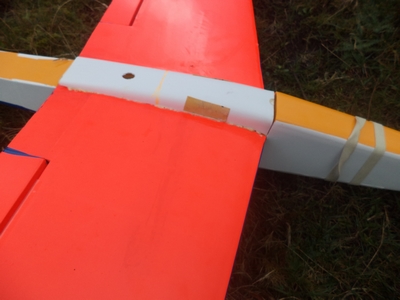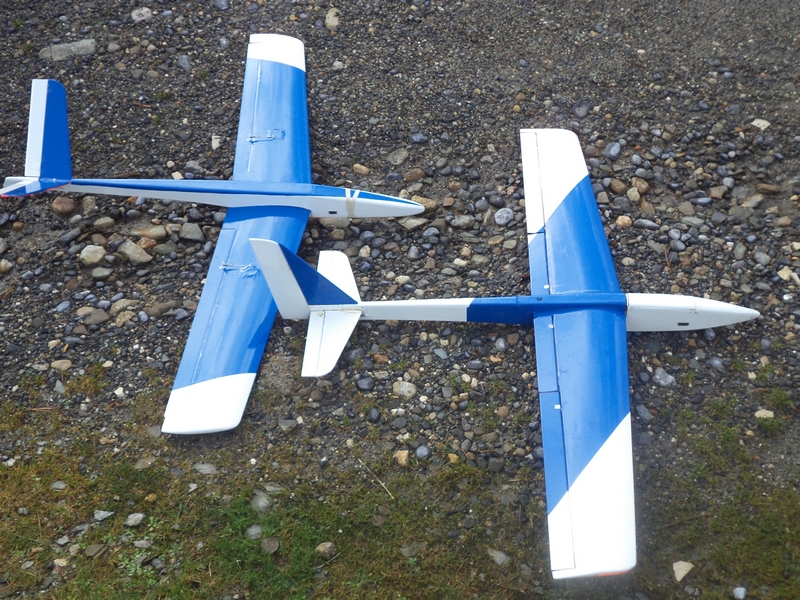Do you have trouble getting to sleep at night?

Keep thinking about the todays events, do you? and worrying about what tomorrow will bring? :cry:
Relax, and read this report. It’ll have you catching up on those zzzzzzz’s in no time. :arrow:
And it came to pass that the day to maiden the Solange arrived.
Bedecked in the Keithy’s standard colour scheme, Blue and white on top, Red and a yucky mustard colour underneath, she was displayed to the world for the first time on the west slope of the Big L.
Wind was an almost constant 25Kmph straight on to the slope. Good visibility. Ten degrees Centigrade.
Because I hadn’t enjoyed building this model I had pre-formed the opinion that I wasn’t going to like her flying characteristics either. Apart from a couple of ’niggles’ she proved to be quite a pleasant little flyer in fact.
Once out in the lift it took four down clicks to bring her into straight and level flight. The lift was nothing great but she floated along rising nicely on the lifts and not loosing too much height elsewhere. Turns were firm and precise. The Stall was gentle and clean, with no inclination to tip stall and, bearing in mind that for this first flight I had put her CoG 10mm forward of that recommended, her 360 rolls were pretty good. Not fast and a little barrel’y (Not axial) but pleasant enough to watch with no great loss of height. Loop-the-loop? Well yes, all models will loop given enough entry speed of course, although inverted flight didn’t seem to be her forte, not today anyway.
It wasn't really the conditions to test for flat out speed, that will have to wait. I was quite impressed with the amount of rudder authority she has. I’ve only flown a couple of other V tails with rudder operation and this Solange has much more than those others. Stall Turns are quite easy and without the need to input aileron to sharpen the turn in.
How about the landings? I’d already mixed in 25% down elevator with the spoileron function for air braking. When I tried the brake, while she was out in the lift, no unhealthy pointers were noted so in towards the landing zone I bought her. A procedural turn bought her into wind, and she slowed up considerably, but not enough to land so out she went again into the lift. A slow sweeping turn out to the right, to bring her over the L.Z. again, and another turn into wind but this time I fed in a little brake. After a pause she started to loose height and slow down. Gentle forward pressure on the stick with a wee bit more brake had her nestling onto the grass and slithering to a halt. All in all, pretty satisfying.
It’s too early to say whether this model will replace my love for the Phase 6, frankly I rather doubt it, but this is a stable little model with no apparent flying vices. I say
“Flying vices” because, as I said earlier, she does have a couple of niggley ‘difficulties’ shall we say. But certainly in her present set up (with forward CoG) she would make a nice advanced trainer/ intermediate model.
As I see it there are two problems. (Oh sorry, we don’t have problems in this day and age do we! I should have said “there are two issues”, ) although one is more ‘inconvenient’ than a problem as such. Being a low wing model the wing, obviously, attaches to the bottom of the fuse. This means that to fit the wing you have to turn the fuse up-side-dawn. The problem (issue) here is trying to keep the V tail off the ground while connecting the aileron servo leads and securing the wing bolt. This can be overcome by using a model stand of course, but then I’ll have to remember to bring one with me to the slope. I don’t have to for any other model so I’ll likely forget it as many times as I remember!
The other problem is a definite problem, (big issue) and it comes back to that narrow belly pan under the wing.
With most high wing/shoulder wing gliders there is plenty of fuselage to grip around the CoG when launching it. But with the Solange I could barely hold onto the model for launching by myself. If I tried to hold the fuse forward of the wing the model ‘fell’ backwards onto my forearm. (Making for a very high angle of attack) If I held the fuse rearward of the wing the model nosed downward. (That’s not much good either)
The only place to hold the model near the CoG is by using my figure tips to grip the sides of that thin belly pan.

I had stuck some fine sand paper either side of the belly pan to try and give myself some more grip. It worked a little but trying to launch this plane by myself in strong winds, or with a gloved hand will be almost impossible.
The only way round it is to have someone else launch it for me, or drag out a bungee on top of the slope and launch her straight out into the lift with that.
Knowing how much of a lazy sod I am, I probably wont bother with the bungee. So this is almost certainly going to be a fair weather model only.
Still not asleep yet??? Oh well, read on……………..

Here is the Solange and the Phase 6. With almost the same W span, fuse length, and tail moment. As you can see the Sloange has a greater sweep on its wing and has a slightly larger Chord. The airfoil section is completely different. Although both are semi symmetric the Solange is more “Flat bottomed”.
The Solange is sporting the very latest in white nose bands today. ( Because I haven’t figure out a way of holding the top of the canopy on yet.)
Whilst flying the Solange today I noticed an ‘anomaly’ while she was flying straight and level without any input from me. She tended to build up a slight oscillation in yaw. If I inputted any rudder, aileron or elevator the oscillation would stop immediately.
I wondered if I should have fitted the larger sub fin below the V tail as recommended in the manual. But then I thought that there are plenty of other V tails with no sub fin at all and they don’t have this problem with yaw oscillation.
I only flew the Solange twice today but I noticed that by the second flight this oscillation was getting more pronounced. Unable to figure a reason for it I flew her low and close to me across the landing zone. It was then I saw the apparent cause.
The V tail was loose relative to the fuse and the yaw movement coincided with the ‘wobbling’ of the tail.
Once again I took her out into the lift, swung her round to the right in a large sweeping turn,…. back over the LZ,…. turn her into wind,…. apply a little bit of brake,…. keep the wings level,…. slight forward pressure on the stick,…. She touched down sliding over the wet grass to come to a stop.
Inspection of the tail showed the tail was indeed loose. It’s retained by a single M4 nylon screw. I imagined that this must have come loose. However, a half turn with a screwdriver merely caused the head of the screw to break off! I don’t think that the little M4 is up to the job. I’ll glue the whole of the V tail to the fuse before I take her out again for further trials.
Another little job for the workshop.
Are you still awake???
Look,….here’s a trick for getting to sleep that works every time.
Just lay on the very edge of the bed,……..you’ll soon drop off!……………………………...... :lol:
L. Keith